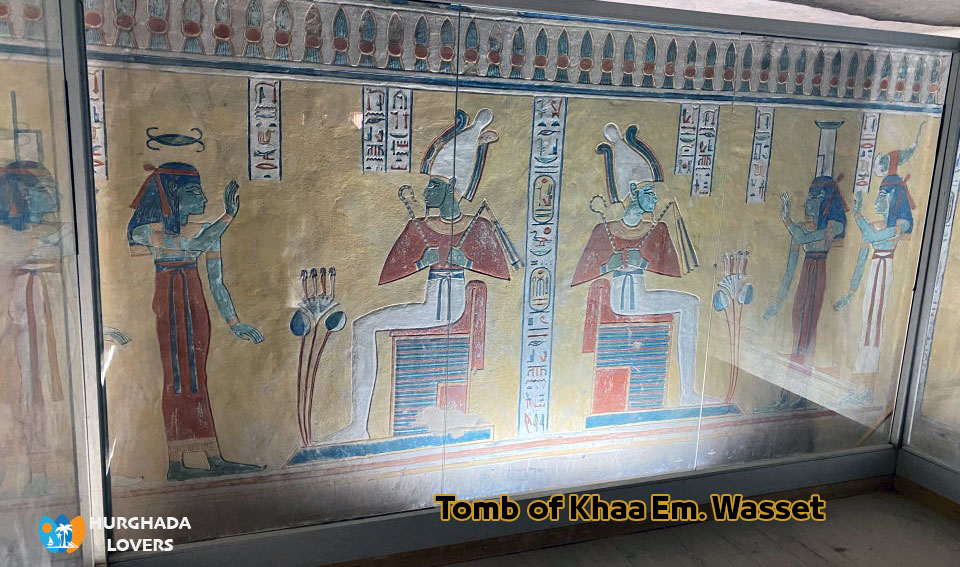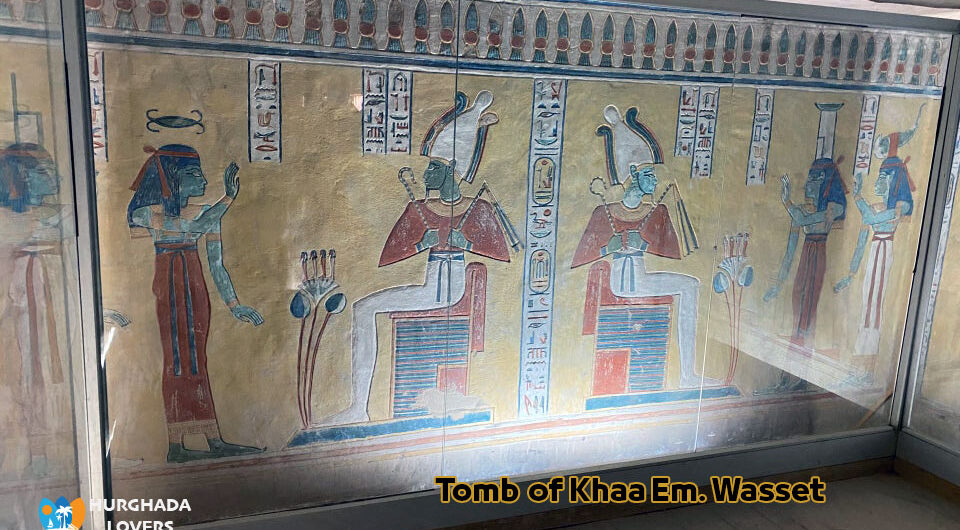Tomb of Khaa Em. Wasset “Prince Khaemwaset” in Valley of the Queens, Luxor, Egypt – Egyptian Tombs
| Facts about ancient Egyptian civilization and the history of building Egyptian tombs, the 19th Dynasty, tomb design, visiting hours, entrance ticket prices and more about the history of the Pharaonic civilization “Ancient Egypt History“.
All historians, archaeologists and Egyptology describe Prince Khaem Wast, the owner of the tomb we are talking about, and of whom there is actually a statue now in the Berlin Museum, as the first Egyptian archaeologist, the first archaeologist in history as a whole..
Tomb of Khaa Em. Wasset Facts
He was able to successfully implement the plan of his father, King Ramses II of the Nineteenth Dynasty of Egypt, The New Kingdom of Egypt, to succeed in restoring all the antiquities owned by his ancestors, making him the first restorer known in history..
Tomb of Prince Khaemset, the prince is considered the son of King Ramses II, the most famous of the Egyptian Pharaohs kings.
He died at a young age before becoming king of Egypt. The tomb consists of an external corridor that leads you to two chambers and an internal corridor that leads you to a burial hall and a domed ceiling..
When you enter the tomb of Prince Khaemwaset, you will see Pharaonic engravings of the God Ptah, the most famous of the Egyptian deities – Ancient Egyptian gods and Goddesses, in the same shrine as in the Ancient Egyptian religion, then a drawing of King Ramses III and the prince worshipping the God Thoth, then other engravings with the God Anubis.
On the right wall you will find drawings of King Ramses II worshipping Ptah, then engravings offering his son to the God Geb, the god Shu and the God Atum as in the myths of the pharaohs..
When you come from the left of the room, you will find a corridor on the wall with engravings of the gods Isis, God Nephthys, God Neith, and God Serket with the priest God Horus, the supporter of his mother.
On the opposite wall, you will see the children of Horus and Neith in front of Anubis, then engravings on the back wall with engravings of God Osiris with God Isis and Nephthys..
Then we come to the room on the right of the hall. You will find engravings of Neith, Selket, Nephthys and Isis.
You will see above the door of the tomb’s sanctuary a drawing of the winged sun disk in addition to drawings and symbols on the door..
When you head left, you will find engravings of Anubis protecting the tomb of Prince Khaemset, with a lion under his feet, then Pharaonic engravings showing King Ramses II offering sacrifices to the god Thoth, and when you head to the other side, you will find engravings of a lion protecting the entrance..
King Ramses II was interested in making drawings with his son offering incense to the god he worshipped.
On the other side, you find Pharaonic engravings of Osiris sitting on the throne, with Neith and Isis next to him on the left, and Nephthys and Selket on the right, then engravings of the sons of Horus emerging from the Pharaonic The Egyptian Lotus Flower in front of Osiris, indicating the development of the art of Sculpture in Ancient Egypt and Architecture in ancient Egypt.
Who is Prince “Kha Em Wast”?”
Prince Khaemwaset was a pharaonic prince, a scholar, an archaeologist, and a pharaonic priest who belonged to the ruling period of the Nineteenth Dynasty..
He is like the fourth son who came from a father who was a pharaoh, Ramses II, who was at that time the most famous of the pharaohs in ancient Egypt, and his mother was one of the very important or main wives in the period of the first years of the reign of King Ramses II, and she is the famous pharaonic queen Isi-Nofret..
Description of the tomb of Prince Khaam-Um-Wast
In fact, the tomb of Prince Khaem Wast consists of an external corridor. This corridor will direct you to the presence of two rooms and also an internal corridor, which will take you or direct you to that hall that was designated for the beloved burial and in it there is a domed ceiling..
Then, when you enter that tomb, you will see a number of Pharaonic engravings that belong at the same time to the god Ptah in that Pharaonic chamber of that ruling family..
Then we find that this drawing dates back to King Ramses II, and with him in the same scene is the prince, the owner of the tomb, worshipping the god Thoth. Then there are other drawings and engravings of him with Anubis..
You will also find on the wall on the right side of the tomb drawings entirely of King Ramses II worshipping the pharaonic god Ptah, then a group of engravings in which he presents his son to the goddess Geb..
Also, when you look to the left of that Pharaonic room, you will see that there is actually a corridor located on the scribe of that wall in which there are engravings of the significance of the Pharaoh Isis and both Nephthys and Neith and Selket with that priest at the same time Horus, the supporter of his mother..
Description of the room on the right of Tomb of Khaa Em. Wasset
Then we come to the room that we find on the right side of the hall, and in it you will enjoy the presence of a group of engravings that pertain to the goddesses Linit, Selket, Nephthys, and Isis..
Not only that, but you will see in the tomb of Prince Khaem Wast at the same time above the door of the temple of that tomb a drawing, that year represents the winged sun disk, this of course in addition to the presence of a group of drawings and symbols drawn on the door from the outside and its father.
We also find that the Pharaonic King Ramses II was clearly interested in making ancient Pharaonic drawings that remain with his son, the prince, presenting him with a group of incense sticks to the mother goddess whom they worshipped..
Note: Facts and secrets of the history Tomb of Khaa Em. Wasset will be added soon…
Hurghada Excursions Lovers, Best Travel Agency in Hurghada to provide daily tours to visit the Tourist attractions of Luxor by Hurghada to Luxor Tours and Hurghada to Pyramids Trips. Book online when you come to Hurghada, El Gouna, Sahl Hashish, Makadi Bay, Soma Bay, Egypt Tours Packages.

